 |
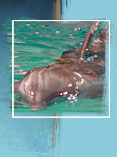 |
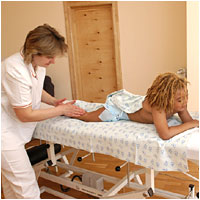 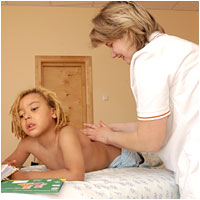 |
Manual therapiy: the intensive Neurophysiological Rehabilitation System, the Kozijavkin method
What is a day of treatment like? Therapy begins on the second day; it is oriented to the individual requirements of each patient. Therapy includes the preparatory, special whole-body massage, accompanied by a reflex therapy for the places of attachement of hypertonic and hypotonic muscles. the vertebral column is then corrected by unlocking. Remedial gymnastics which are geared to each patient are intended to consolidate the achieved result and form new physiological movement patterns. This is supported by joint therapy, which involves mobilization of the large and small joints. In addition, a bee poison therapy (apitoxin therapy) is used insofar a there are no allergic reactions known; a beeswax treatment is carried out otherwise. Mechano and play therepies are provided in order to promote inner motivation; treadmill training or special fitness exercises (physiotherapy) take place as appropriate. What are the characteristics of the individual therapeutic elements? 1. Unlocking the vertebral column 2. Joint therapy 3. Reflex Therapy 4. Remedial gymnastics 5. Massage 6. Rhythmical music therapy 7. Apitherapy 1. Unlocking the vertebral column Objective: It is intended that a new functional condition of the entire body is achieved by releasing blockages at the level of the vertebral column joints, this enabling new patters of movement to be learned. Method: A specially developed manual therapy in the form of a simultaneous, multistage mobilization of the locked vertebral column segments is at the heart of the Intensive Neurophysiological Rehabilitation System. This is begun in the lumbar area of the vertebral columnn after appropriate preparation. The dorsal vertebral column is then treated and, finally, the cervical vertebral column is unlocked. Several vertebral joints are relaxed by a rotation motion in respect of the body axis. In contrast with rotation inclassical manual therapy, which is always carried out forwards (ventrally), the principle underlying our metod is backward (dorsal) rotation via the Spina iliaca anterior superior. The entire vertebral column is thus integrated into the unlocking therapy. Intensive mobilization of the cervical vertebral column is performed last. We unlock several segments here too using a special sudden rotation of the head. These manipulations take place once a day for 12 days. The remedial gymnastic measures of relaxation and mobilization continue in parallel. Patients and their parents are actively integrated into these measures. They enter their exercises into a diary and record the changes. Results: A completely new functional condition of the body is created by relaxing convulsions and contractures, by improving the circulation of blood and the metabolism and by braking pathological reflex patterns. This effect comes about both on the horizontal plane (vertebral column plane) as well as on the vertical plane (brain and bone marrow tracts). 2. Joint therapy 3. Reflex Therapy |
||
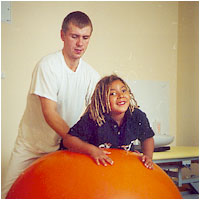 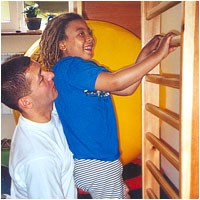 |
4. Remedial gymnastics
Objective: Gradually activating the patient’s possibilities of movement for building up a new, optimum pattern of movements and improving movement coordination, activating the inner motivation ofthe patient, stimulating processes of plasticity in the brain. Method and Results: - Based on the classical principles of physiotherapy, which are individually varied from pationt to patient. - The activation of the patient’s possibilities of movement is carried out gradually: from simple to complicated movements, from passive to active movements, from the centre (brain) to the peripheral regions of the body. - The movements in the joints are carried out actively and passively up to the physiological limit; the number of repetitions, the speed and accuracy of the movement are increased on all planes. - Exercises for reducing the supporting area and for developing the spatial feel of the body are gradually applied. - Use of special breathing exercises, especially in the case of patients with athetoses (these are diseases with continuous, involuntary, slow movements of the ends of the limbs) as well as for the purpose of learning the physiological function of respiration by play; This function of respiration is usually not very well developed in the case of patients in the phase after craniocerebral trauma. The special breathing exercises result in the entire body being better supplied with oxygen, and this contributes to the stabilization of the entire respiratory situation. - For activating inner motivation: demonstrating the new functional possibilities by using elements of play, dance, music as well as participating in special sports competitions (patients’ Olympics). - Use of special biomechanical computer game programs which have been developed in the rehabilitation centre for activating and improving the control of movements in the joints and in precision motor skills, coordination with induction by direct feedback for the patients. |
||
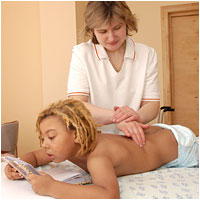 |
5. Massage Objective: Relaxing hypertonic musculature, reducing muscle tension (myotendinoses) and relaxing contractures as well as stimulating hypotonic musculature. Preparing for unlocking the vertebral column joints and intensifying its results. Method: Heavily dependent on the sensitivity of the masseur, who searches out myotendiones, trigger zones and contractures and individually treats them according to the classical principles of massage, point massage, extension massage, acupressure and lymph drainage. A whole-body massage is carried out, which leads to a decompression and relaxation of all the joints. The massage accordingly relates to muscles, tendons, ligaments, joints and the entire vertebral column. Results: The massage leads to a stimulation of the mentioned elements as well as to a reflex effect on the internal organs and on the entire metabolism of the patient treated. There is also an optimization of the muscle tone, resulting in an improved functional condition of posture and movement. This has an effect on the entire body. |
||
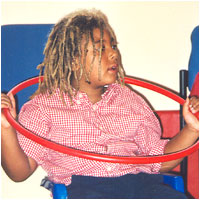 |
6. Rhythmical music therapy 7. Apitherapy (bee poison therapy and beeswax therapy) More information under: www.reha.lviv.ua |
||